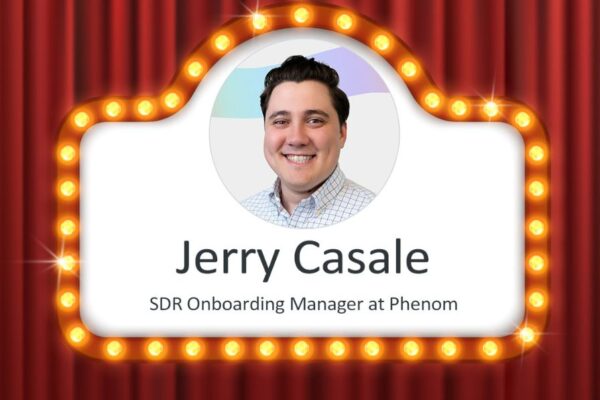
Outbound sales continues to evolve at breakneck speed. Trying to keep up with the pace of change, many sales development teams find themselves at a crossroads with respect to crystallizing outbound sale strategies, deploying new sales tech, and improving SDR performance.
To help make sense of this current state of flux, here’s our take on five critical questions related to outbound sales challenges and finding the right solution for your sales funnel, as well as a sneak peek into the future of sales development.
1. What is the best strategy for consistent outbound results (by account, by territory, other)?
One issue that almost all outbound sales teams struggle with is lack of consistency. We’ve all seen a great month where SDRs over-perform, followed immediately by a clunker. One source for this volatility is the tendency to focus on a single tactic and channel.
Whether named-account or territory-based, putting all your chips on one outreach strategy can be a risky proposition. The key to getting consistent results is having a healthy mix of tiers, named-accounts and territories, and giving your SDRs the flexibility and agility to self-prospect and find their own accounts.
Let’s take the named-account approach as an example. Each SDR is given a list of accounts for the quarter and works only on that list. That’s fine until sales leaders realize a few months later that SDRs don’t have enough on their plate and can’t meet their quota. Then they tell the SDRs to self-prospect.
No matter how amazing the strategy you choose is, if you use only one you’ll inevitably end up getting stuck. Using a diverse assortment of strategies will give you stronger SDR performance and more predictable results.

2. How do you determine which sales tech solution is most appropriate?
If you’ve decided to evaluate new tech solutions, here are three important questions to ask yourself before approaching vendors:
What are the weaknesses in your existing processes?
Before you start evaluating tech solutions, dig deep to understand your organization’s pain points and the challenges you’re trying to address. For example, many customers approach us because they realize they want to scale and improve their existing prospecting and engagement processes through automation.
Does the technology fit the needs of my specific industry?
Intent tools (by way of example) may be the next big thing, but maybe you have a new technology for which no one is currently showing intent. Data sources may have amazing data for 70% of the cases. But what if you’re in a niche market, and they don’t have the data for your target audience?
Does the solution address my specific use case?
You may be in a specific industry that requires a unique workflow or solution that is different from the “typical” SDR operation. A tool that was a great fit for one company may not necessarily be right for the same team in another company. Dive deep into your use case and define your specific requirements before you start to evaluate new tools.
3. What’s the best way to justify an investment in sales tech?
Driven by the need for fast growth, sales organizations pour money into hiring people without giving them the proper tools, training and structure they need to succeed. This explains the paradox of CFOs who claim they don’t have $50-70K for a solution, when they have no problem hiring 5-10 additional sales reps or SDRs.
Calculating sales tech ROI is a great way for sales leaders to bring their CFO on boardfor a new solution. Before approaching your CFO, ask your vendor for quantitative results achieved by companies like your own organization in terms of number of SDRs and type of sales process. For example, X% efficiency increase, Y% time savings, and a performance improvement of Z% for each SDR.
In this way, you’ll have a solid basis for calculating the ROI. Futuristic VP Sales – those leaders focused on maximizing their team’s success – can and should use ROI to justify their sales tech purchase.
4. Is it better to invest in sales tech or hire more sales reps?
When making budget decisions, management often faces the dilemma of whether to hire an additional sales rep or SDR, or to take the financial equivalent and invest it in better sales tech for the entire team.
The answer depends on the size and maturity of your team. If it’s your first or second SDR, by all means hire. But if it’s your eleventh SDR and your existing 10 SDRs are not performing at an acceptable level for your industry (either due to lack of training, tools or processes), there’s no point in hiring more. You’re only setting them up to fail in meeting their quota, which will eventually cause them to seek a better opportunity somewhere else.
In such a case, the wiser decision is to invest in sales tech. Focus on improving processes and efficiencies, invest in technology and sales ops that will help your team deliver results – and only then add headcount.

5. Where Is outbound sales tech heading?
The concept of outbound sales, based on finding prospects who weren’t looking for you, is no longer sustainable. Buyers hate it because they’re being bombarded, and sellers hate it because they have diminishing returns, which leads them to crank up the volume even more. Then buyers get fed up and ignore everything.
AI could be the way out of this vicious cycle. AI can analyze buyer needs and behavior and match them to the most relevant sellers – minimizing the noise and creating more relevant connections. To do this effectively, you need a lot of data as well as machines capable of continuous learning and improvement.
Once machines master the matchmaking process, SDRs will be able to reach out to fewer people with less volume and get better results. In this way, AI enables outbound to be more like a metric, and less like a cannon.
We firmly believe this is the future direction of the industry, and RightBound’s AI-driven engine is already being used to do just that.





